Clean Livin'
A conversation between Steve Badgett of SIMPARCH1 and Nance Klehm2 , regarding their residency project at the Center For Land Use Interpretation3
page 1
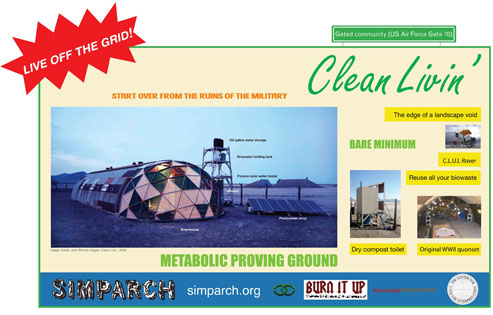
The project Clean Livin' began in 2003 with funding provided by a Creative Capital grant. This was a SIMPARCH collaboration with the Center for Land Use Interpretation (CLUI), aimed toward designing and building a live/work facility for their residency program on a historic army base in Wendover, Utah. CLUI wanted to offer "south base, an abandoned and remote part of the site, as a location for research and production. SIMPARCH made south base habitable again by installing systems for solar power, water storage/reuse, and soil making. The base's remaining WWII Quonset hut was rehabbed to be the primary structure for the project. Residents make a six-mile round trip to bring water to the site, via either a two-seater water bike or a trailer hitched to a standard bicycle.2 Water is pumped to a tank atop a twenty-foot tall tower, where it is gravity fed to the kitchen, shower, garden, and solar stills.
The antithesis of the site's original use of the base for training and weapons testing, Clean Livin' is a proving ground for alternative energy and low-impact living systems. Individuals and groups have used Clean Livin' for varying amounts of time, from short visits to several months, since 2003. Sometimes participants are there during short periods of Air Force or SWAT training. A SIMPARCH team revisits the project every year to make repairs and improvements. Nance Klehm joined the project in 2007 to work on biological systems4, pursuing soil-making, water-reuse, and planting strategies in order to help fulfill the project's original goal of autonomous living.
Since the inception of Clean Livin', two related SIMPARCH exhibits, DWI (dirty water initiative)5 and Hydromancy6, used water purity on the U.S./Mexico border as subject matter.
page 2
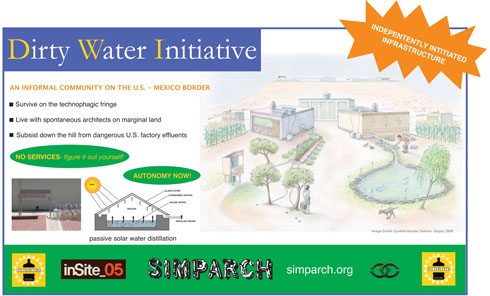
LIVING CLEAN
Nance Klehm One of the questions that I want to ask you straight off is, in this work that we are doing at Wendover, do you feel comfortable even calling yourself an artist? Do you have a name for yourself for what you do there?
Steve Badgett It's more like we are "armature makers, operating in a more technical than conceptual mode. But it's hard to do that without some kind of initiative like an art project, and it's easy to question the aesthetic value of it. We are still involved with the art-world paradigm of exhibiting in museums and biennials, but we are pushing an idea outward, [to a point] where knowing about the project's foundation in art is not important.
N What's interesting about Wendover is that it started as an art project but has quickly become something else, an experimental facility for how one could live.
S Credit has to go to the Creative Capital foundation for believing in the project enough to offer us a generous grant. But from an "and arts" perspective, the point is to allow people to get by on the edge of this landscape void, which we made possible but only by living within limits. We don't want it to be a burden to stay there and we hope that the exposed life-support systems demonstrate a reasonable alternative to the infrastructures we unconsciously rely on. The military is about fast, intensive movement and enormous resource use and waste—you get your job done and then move on. We like the fact that the project is reusing this abandoned location of intense military activity in a completely different manner—slow and contemplative, with fewer explosions.
page 3
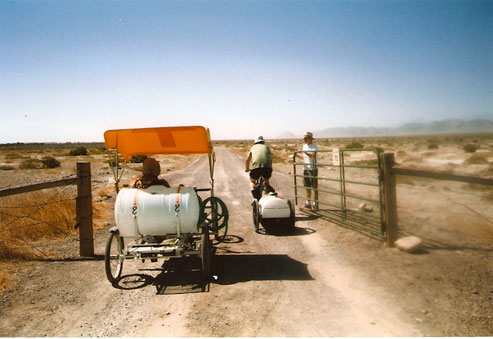
N There is a certain need for those systems in this place with no power or water, but then you're building armatures for shade, you're building structures to inhabit the space and [to serve] a lot of other needs for daily use—so "armature maker" seems an appropriate term, whereas "installation artist" implies a solely aesthetic intent.
S Our design is based on necessity, decisions coming from a variety of considerations for this unorthodox situation. In this collaboration with CLUI, we saw the opportunity to actualize our curiosities about soft technology and minimal living in the desert. We work in some balance between shanty dwellers or squatters in informal communities along our U.S./Mexico border, and ideas of off-planet living, space-station fantasies: as in the film "Silent Running" or the Biosphere II experiment.
N Why do you think we are both working on water projects where we want to attempt a correction to existing systems? Why are we so hot and bothered about that?
S An interest in experimenting with building, engineering and design using commonplace materials has been part of the work from the beginning, but in the past few years it's evolved into making something functional/useable. We are always asking what is worth doing, or how can we be generous with a project? Ever since I can remember, I've had a nagging sense of failing policy, failed institutions, so I think that's behind the eco-related projects. You must feel this, too. But we are artist minded more than activist minded, so need a creative imperative for our projects. Water is a big subject, but generally it's very upsetting and perplexing to see it mistreated, treated as "industrial stuff." The relationship a society has with water seems to be a good indicator of its successes or shortcomings. So we do projects about ways to improve water and land use, small gestures toward imagining a vast restructuring of the human relationship with environment—an aesthetic on a planetary scale, dealing with abuses wrought by development. If you are an artist, you have license to explore issues critically, or you do it as a matter of course.
You've been on a focused path of eco-ethics for nearly all your life. I would ask you the same question—about your motivations in doing your work and living the way you do. You live by your beliefs far more than the rest of us.
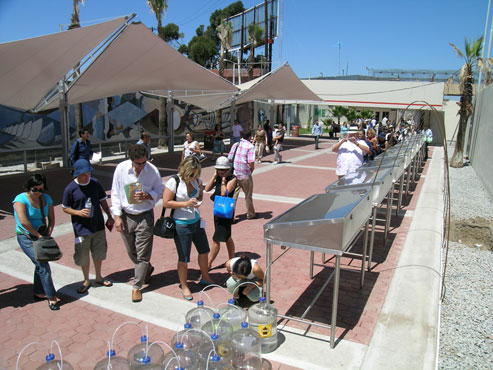
page 4
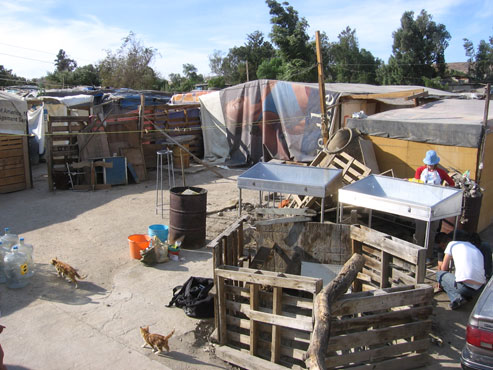
N My interest in water is in how it functions within the system we have and the system we could have. The perspective of "closed systems" allows for a more conscious use and reuse of water. And the truth is, we are working with closed systems but aren't thinking "closed system." Optimally we use/digest water, then return it to the soil in good shape so the soil, rocks, and plant life can naturally benefit from it and also filtrate it, which makes it cleaner for reuse. That is how I explore things in general, as if I lived in a space station. ‘Cause I believe we actually do.
S The wild and wonderful seems to be totally gone from our lives, and it's about rejuvenating that via your work using microagriculture, guerilla gardening, foraging—where you inhabit an urban situation of diminishing green space.
N I grew up on a farm where input/output was traceable. We don't know where things go in the city. The wild [nonindustrial flows and processes] haven't disappeared in the city, they just need to be noticed, fed, and amplified. That is what I am trying to do—lift it so it is noticeable, rediscoverable.
SYSTEM FATIGUE
S Artists play with self-referential systems. To work in a real situation seems more pleasing. To engender a new system in a community that might take root, that's more satisfying to me. Though I value it and came from it, to only deal with a hermetic avant-garde is not enough, or not my strength. As you say, one needs to "get messy" when trying to make something happen at this level. Where do you stand with the traditional structure of the art world? Where it is okay to do useless aesthetic acts?
N Not so interested.
S But hasn't it helped you do creative but useful explorations?
N I use aesthetic strategies to reintroduce ecological ideas, old ideas.
S But did you need the art world to do that?
N Not really. They've come to me for content—grist for the eco-art mill.
S So, you're more or less ambivalent?
N Yes, it makes me tired. Hey, you've gotten as much resistance from the art world for that approach as have I.
page 5
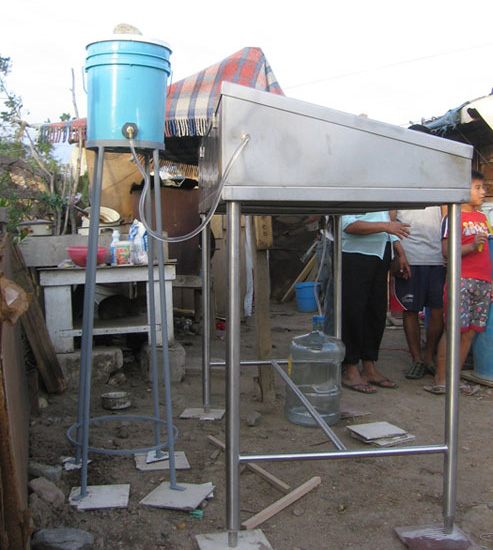
S It varies. Other work is not eco-oriented and heavy in resources. SIMPARCH get more inquiries because of our reputation of doing big interventions. That's getting harder for me to do, ethically, so something needs to change. I think, okay, combine the two—big intervention and a permanent, valuable project for a community. That takes a lot of maturity, focus, and sacrifice—not glamorous. I can see a lot of art institutions not wanting to support that type of project, because the process is long term and may not have a "big wow." Though, there are signs that art institutions are slowly changing.
Now there's always news about problems with water, waste, big agriculture—the failures keep emerging. It could be a new role for the artist to look at the bigger picture, a more systematic approach to see what's not working and then help guide whatever industrial approach toward a more holistic, less destructive method. Forty years ago Robert Smithson said industry needed to work with artists.
N I think the only failure of the artist is not being on a project long enough to respond to their experiment's feedback.
S I agree. Many are hit and run, getting the documentation, then on to the next thing. Increasingly. there are initiatives for artists to work with government on projects with ecological imperatives. Negotiating the bureaucracy seems tricky but this is something that can be learned, or should be taught. I was looking for a new institution years ago, and I found it in the Center for Land Use Interpretation. CLUI seems to operate by creating an awareness that has profound implications. Not art, not activism—something hard to define. They gave us our first opportunity to make a permanent SIMPARCH installation, their first living facility in Wendover.
N CLUI is a different sort of institution. They continue to build a presence in Wendover. They have an extended commitment to a place, a community, a network of relationships.
S Yes, a lot of healthy relations in unlikely places around the country.
N And even if SIMPARCH has been working at south base for five years, no one knows if those relationships in Wendover are going to end or not. Some of the things we and others are trying out there are a little edgy, and the question circles around again. Will these projects damage the relationships they've developed? With this exhibition space? With our residency, etc.? CLUI has a broader, deeper relationship with the town. A lot of the sites that CLUI uses as research stations or even residencies are simply borrowed for some indeterminate amount of time. There's no lease or contract, it's just all built by some sort of curiosity, generosity, and flexibility.
S It injects life back into something that has fallen by the wayside. So that could be what an artist's role is—invigorating, bringing attention to, adding energy to something that's been neglected or forgotten.
page 6
SHIT BURNERS
N How do they handle water and waste situations in military campaigns? What do they poop into?
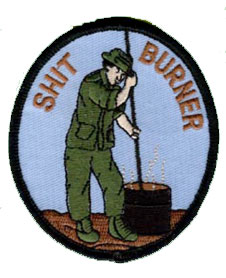
S As far as I know, barrels—burning the waste. I have an unofficial military patch where this guy is standing over a flaming barrel, a low twenty-gallon barrel, and the text is "shit burner." With water they must just truck it in. I haven't researched that, but I imagine that it's energy intensive. I heard that petroleum can cost up to $400.00 a gallon in far-off battlefield situations these days. What a staggering amount of waste when it comes to getting rid of crap—though not a surprising military solution.
Our western scenario is leading all the drainage to a giant facility for "treatment, which, for all the beneficial sanitation it creates, was recognized by Victor Hugo in 1862 as taking two good resources and making them into something vile and useless (aka shit water).
N In Chicago waste water goes from flush to tap in two weeks. This is a very chemical and energy-intensive process. The hardest thing is to get urine out of water. Solids are easy.
S Can you imagine a different scenario instead of this big sanitation?
N Constructed wetlands for processing human waste are already happening in Mexico City and smaller-scale communities. Obviously, this is a good choice for new communities without infrastructure.
S Yeah, that's what I observed after seeing these communities on the border—there's a praxis of having no infrastructure. There's potential to use the effluent for green space and the solid waste for enriching soil in the desert.
page 7
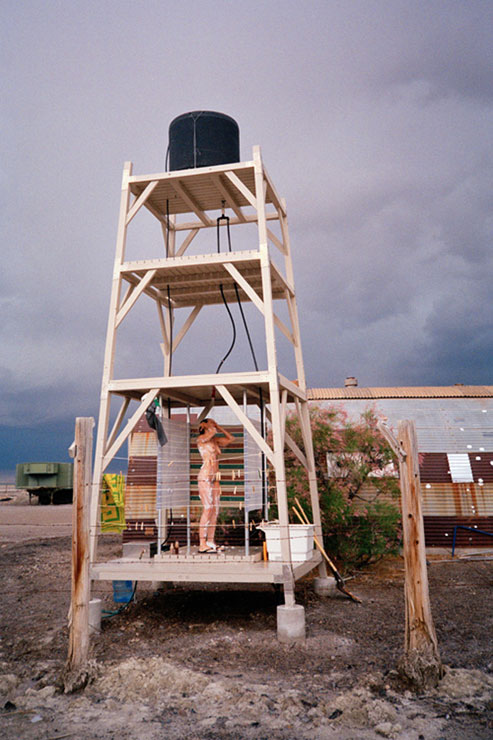
N We're doing something similar then by getting city water, bringing it to the site, storing it, and then pumping it through our system. There is a springhead that Wendover, Utah, is tapping from up in the mountains, which is piped to town several miles away. When we are living at the project site we need to bike city water fifty-five gallons at a time, a six-mile round trip, from the other CLUI facility. We had one of our visitors who was taking a long shower every night and I wanted to yell at her.
S Right, and now we have solar-heated water, which will likely lengthen shower times. Presumably people become more careful, after the novelty of biking six miles for water wears off. I have realized that a good shower can be had with only five gallons, dishes washed with two gallons, teeth brushed with one cup. If you have an imperative, you can get by comfortably with very little. There's a stunning difference of water use across the border. Where in the U.S. 90 percent goes down the drain still clean, in a border home the water is reused two or three times—first as bath water, then clothes wash, then floor mopping, for instance. Depending on the household, they pay for 100–200 gallons a week to be trucked, whereas we average 150 gallons per person each day with our modern plumbing.
MEXTRATERRESTRIALS
N What draws you to working in communities on the U.S./Mexico border?
S The best part of being involved with these communities is seeing how they're surviving—they're the "informal architects of our postmodern future, as described by priest/philosopher Ivan Illich, who did groundbreaking critiques of industrial society and is regarded as a founding thinker of the ecology movement. He described the poor of our high-tech entranced world as the "technophagic majority" —people who exist on the waste of development. So, with an informal community surviving on the U.S./Mexican border, the question of how to improve management of what little water they have seemed like a great, interesting problem to solve.
You don't get it in the news, the details of their struggle. Lack of water is obviously a huge problem to settling there. The first night we were looking around and we noticed that they had working televisions first, before a water supply.
N That's because it's easier to pull power than it is water, especially clean water. I love those nests of wires; it's really amazing how people are pulling power from each other.
S From a gringo's point of view it looks "backward, but then you realize, you do what you can when you can. A wire on a pole is easy to install or grab power from. We found out that moving water around is not easy at all. Water has a mind of its own. A roofer said that he has to "think like water, imagining where future leaks may occur. And a plumber I knew used to say to his customers, "your shit's my bread and butter." Plumbing is difficult, messy. While constructing Clean Livin', we delayed doing a proper dry toilet for weeks, just digging a small hole for each occasion and crapping behind a building—a humiliating situation.
page 8
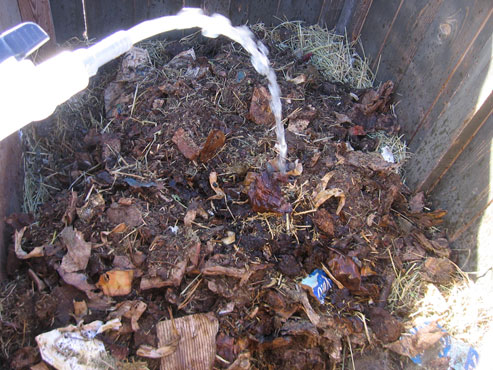
N I would merely say it was a "direct connect"!
S Still, the toilet should've been the first thing we built. Instead, we got the electric going—lights, refrigeration (cold beer), etc., seemed more important.
N Shifting gears here….There are so many examples of poor community development, where outsiders enter a community, make an assessment of what needs to be achieved, and then provide services or build infrastructure to "solve" their problems. When do you deem it okay to do that, and when is it not okay? Or is it just conceited and patronizing to enter a community as an outsider with that paradigm, since most communities have been living with an autonomous system already? For example, people who live by the Ganges bathe in the river, chuck their waste in it, cremate bodies on its water letting the remains sink or float on, and yet people still drink from it directly and it hasn't been treated. People get sick of course, but I suspect if you were to interfere with what they are doing it would not be very well accepted. The people have already worked things out to their liking, for their own purposes.
How do you gage and engage a project? Were the border water projects you did accepted by the people they were meant for? Did you interface with a curator to get that set up, or did you approach people in a grassroots fashion, knocking on doors and chatting with folks to discover how you could help them? How did you sell them on your solutions from the north?
S For Tijuana, it was two levels of contact. The first was with a curator, directing us to the non-profit benefactor institution, Esperanza International. They help support struggling communities, offering economic programs and advice, but also labor for house building. We lived on their compound in south Tijuana. They seemed to be a kind of broker for Christian youth groups coming from the U.S.A. to help build houses. You could see that soon after someone began living in one of these houses, they would build additions onto it, or modify it somehow.
N So the people they were "establishing" were migrating from pueblos?
S I gathered they were coming both from pueblos and cities, desperate and willing to risk finding work on the factory-laden border. From what I gathered, with the foundation it was about efficiency—more for less in strict economic terms, and houses were built of one or two very simple designs. You see a lot of independently built homes, and they are a wonderful array of design and flexibility. The historical complexity in some of these (usually unfinished) dwellings can be something to behold. There are no rules to meeting needs, so things get built in unusual and imaginative ways—a by-product of their difficult economic situation. Not to be revered, but it sure is interesting compared to our standardized, bland housing solutions.
N They're solutions that are highly specific to that particular constellation of people in their environment.
S Right, they are fully engaged in their needs; it's not something imposed upon them. In Illich's terms that is what defines a true place for "dwelling."
page 9
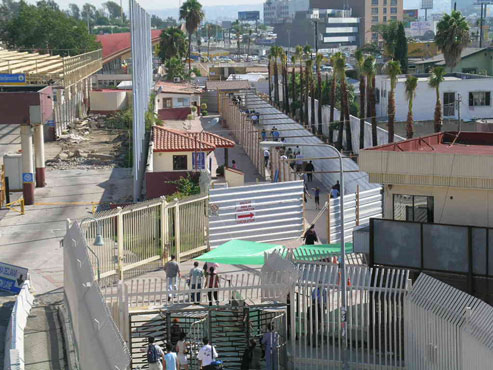
N What was the water situation like before Esperanza worked with them? And then later when you worked with them? Did you work with the people more directly? How did this happen after Esperanza built their little box homes?
S They just introduced us to people who lived in one of these homes, and in one case to a local community woman who worked for them as an organizer. We were looking for people who were needy, but because we were hosted by Esperanza, we were limited to a couple of specific communities. We found out right away that certain communities weren't all that interested in our solar stills. I don't think Esperanza International would go into a bare-boned, newer, informal community where people would be really struggling. This was maybe too risky for them.
N When you talk about "needy, do these people define themselves as needy, or as not being so needy since they have already figured out some other solution to their water problem?
S It varied from community to community and house to house, even. Often needs [for water] were minimally met and people were working towards improvements best they could. we never perceived that people had an attitude of entitlement for services from the government, they just dealt with the situation at hand. over time a community slowly becomes more firmly established and credible in the government's eyes and after ten to twenty years will get water – a pipe to the property line, the homeowner has to bring it into the house. Then, after so many years, the government may provide a way to get water out – provide the armature for sewage.
We tried out a still prototype for people who didn't want it soon after because as they finally had water coming in, had gotten city pipes. Before that they had 55 gallon barrels filled up by a water truck. They weren't really going to drink the water from the still and didn't feel they had to reuse water now that there was an endless supply.
N Does that also mean this community had a sewer system?
S They did not have a sewer system in that community. They will eventually, but it might take another ten years, no telling.
N So they had plumbing come into the house, but where did their effluent go?
S Just out into the road, which is a big problem that makes for crummy roads, getting to and from work, going through these stinky streams. Water finds its own path, anxious to make a river, so the water coming down a hill will join the other water to create a stream. Then cars drive over the stream and make ruts, and then it rains and the ruts hold water. The makeshift power lines, often exposed on the ground, end up in the water, making for "hot" puddles. We heard that electrocutions of children and pets are not uncommon.
N Yikes! There wasn't anybody catching the water, diverting it elsewhere for irrigation or some sort of cesspool to let the microbes have at it?
S No cesspools, no, but "informal" greywater basins occurred. The problem is where/how are they going to use this effluent? They have too much water to use on what little green space they have, so away from the house it goes.
page 10
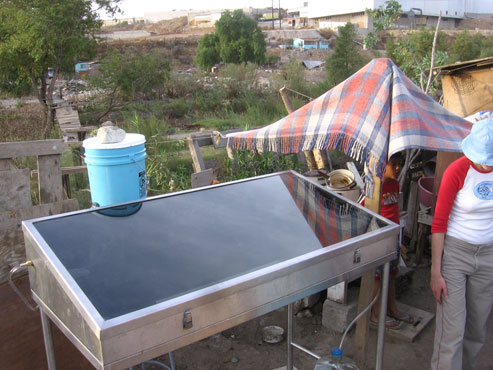
N Was toilet water going out there too, or were they using dry toilets?
S Mostly they were using dry toilets, pit toilets—whereby they dug pits and then moved to another pit every six months to a year, depending how deeply they had dug it and the amount of people using it. In Juarez we were introduced to a very clean economical dry toilet system that came from Cuernavaca (Illich's town). It has two chambers, so you move the commode over to the other chamber after six months or so and let the first chamber compost for six months, then use that "soil" around trees. The commode separates the urine out, which makes things less stinky. You know better than me the different schools of thought on separating or not. We find use for the urine at South Base easy enough, thanks to your additions.
N Particularly the system of combining our urine with our cardboard and paper waste which is simply obeying the carbon-nitrogen microbial composting equation in a very direct and elegant way.
S Yes, and when I was there, I imagined that everyone could at least have this simple way to deal with waste. But, composting toilets cost money—not much to you and me, but more than most could come up with. It was easy to fantasize about improvements, working with them to construct independent and synergistic systems, outsider-engineering masterpieces. That was my conceit as a privileged gringo.
We placed solar stills in a really bare-bones community, called "Nueva Esperanza." This community began about ten years ago next to the river. The river causes terrible flooding a couple times a year, so they have to deal with that. It seemed to me that this community was plopped down almost like extraterrestrials, a human community with no services or no reason to be there except that they are economic refugees, hoping to find work. There was no water going in or sewage going out, only a shallow well of very brackish water, pulled up pail by pail for daily use. People lived in mostly pallet, vinyl tarp, and cardboard housing. Though cheap, this type of simple housing was thoughtfully executed and layout of the community was thoughtful.
N What relationship did they have with the river? Do you remember where they siphoned off the river?
S No. The river was a burden with the flooding, and mediation was definitely not forthcoming. The government did not want them there, so it would not help in any way. My understanding was that nearby ranchers wanted the land. Their "informal" infrastructure included the bridges they built to get across the river, which were mind-blowing—a structural palimpsest. We saw a woman with a stroller daintily traversing this railless bridge that looked so precarious I was really quite cautious crossing it.
We did place three stills there, after first talking to a community leader. She invited us to a community meeting where we introduced the project, saying that we had these units that can clean water and offered to place them there if they wanted. I made it clear that it was a small gesture and an experiment. They were enthusiastic and wanted this experiment, however small, and immediately held a lottery to see who would get the stills. After returning twice, I lost touch with what was going on. I had thought it would be a good place to do a larger, more integrated water-saving project, but I did not pursue it, unfortunately.
N Why not, because of the enormity of the situation or the fact that you don't live there?
S Those were issues, plus I would've been on my own—the only true believer at the time for a project of this nature. But it could have been overcome with persistence, and help does eventually turn up. I suppose it would've taken a greater leap of faith than I was ready for at that point.
page 11
N Getting back to the space station … urine can be used as a fertilizer, a compost activator. It's how we use it at Clean Livin', on south base. It is also antiviral and antibacterial, so one can use it on wounds, stings, and bites—a popular use during wartime. It is highly nourishing to the skin. Urea, one of the main proteins in urine, is used in many beauty products. And "urine therapy, in which one drinks one's own fresh urine, purports many health and healing benefits from the many trace minerals and nutrients contained within.
S Wow! We didn't think of all those other uses, but along with the undrunk coffee, dishwater, and other liquids, we tried to distil the urine left behind by some residents. From a murky, very dark liquid, the distillate came out clear, but when I gave it a sniff I was almost knocked over, because it seemed to be very strong ammonia. The vintage urine may have needed several trips through the stills, or alchemically it was too far gone.
N Yeah, use fresher pee next time. It's great you tried and now understand some basic biological limits, at least. NASA developed a process on its International Space Station, whereby astronaut urine is distilled without using the chemical process that most industrial waste water treatment plants use—they filter it, distill it, and then oxidize it into safe drinking water. It's a regenerative life-support system, though an expensive one.
S A solar still wouldn't work in zero gravity I suppose—too bad, with all those pure hot rays up there.
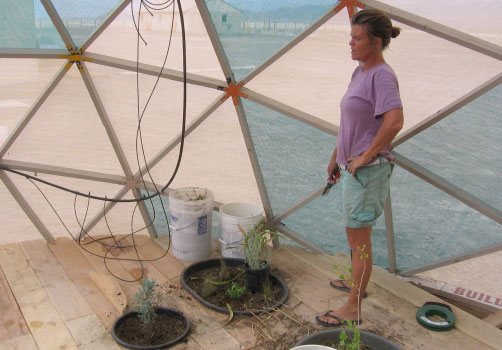
BIODISSONANCE
N The problem with this conversation about water is that it doesn't touch on soil. So much of the world's water source is going toward agriculture in the form of irrigation.
S That's what I mean. If you have an autonomous integrated system, you should be talking about making green space with the resources you have immediately at hand, like grey water.
N I spoke to an agronomist from Utah State about how salt is widely cleaned from soil via flood irrigation. Flood irrigation is used in Tijuana and Juarez, too. Irrigation drives the salt down deep into the soil, deeper than plant roots. Sometime salt-tolerant plants are grown that sequester it. When the English arrived in Australia, they raised sheep (a farm technology they brought with them that is not really appropriate for Australia), and all the soils became highly salty, so now Australians are growing salt-tolerant shrubs that can also be used as fodder for their animals, because there has to be a dual purpose of healing soils and feeding their sheep.
Generally, the problem is if you irrigate soil, you drive the salts into the ground water, affecting people's drinking water. In super-salty Wendover, I've been trying to figure out what to do. To remediate the soils there, we would have to use a huge amount of water, and there would have to be some kind of maintenance program where we plant plants that are very tolerant to salt. Desert water is precious, and we made it more so with having to transport it, so improving horribly salinated soil for growing is tricky. There needs to be a careful balance to make agriculture work there.
page 12
S Why try to fix the soil at a soilless place—an impossible medium for growing?
N I know, it's Sissiphysian, but you embrace the rock anyway and start pushing. It's still soil, but it needs some help to make it viable. That is part of keeping this idea of a closed system—keep the loop tight, don't bring in resources if you don't have to.
S You're very inventive with this remediation, where others would see it as an impossible pursuit.
N Yes—salty water irrigating sweet soil, or salty soil draining into sweet water.
There is a relationship between soil health and the shape of our hemoglobin. The shape of hemoglobin affects how much oxygen a body can absorb. And so there are animals that are slowly suffocating because the soil/water quality is so bad that their hemoglobin has shifted in shape and can't accept oxygen. With constant irrigation of our soils for agriculture, we are depleting our aquifer's water, depleting the soil of minerals, and changing the shape of our blood cells. The agronomist is drawing up a plan for us as to how to remediate the existing soils at Clean Livin', but he won't do that until he knows exactly what the site's water table is.
S Unless we were separating it like we've been doing with growing in planters, or do you want to move in the direction of not doing that?
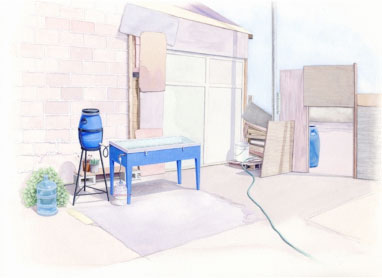
N No, it's good that we are doing that. We need to use multiple ways of working with available soil. It's one of the ways we are working, by not combining our waste and drinking water. Under the roof drip line of the barracks, the soil is sweet, not salty. I've tasted it. I used a pickaxe to break up the existing soil and mixed this with our solid human waste, then mulched it with lots of grass clippings from the casinos to hold in the moisture. Now it works like a sponge. The rain running off the quonset structure and the snow that drifts against it will naturally and gradually flush that soil of salts. After a year, the soil next to the quonset dropped in salinity just by allowing it to be more porous to water and having the added nutrients.
WETDREAMS
N Rain and grey-water rivers carve out paths and become ditches, and when it rains the ditches become rivers—very evident in the desert. What we do with natural hydrology is amazing, like we are manipulating a giant sandbox. I have a deep fear and respect for water, so a lot of this manipulation is irrational. Water always wins no matter how we try to dam and sequester it. We don't go with flow, we try so hard to control it, and the problems are evident.
S Yeah, it is a primal force.
N Illich talks about "the waters of imagination" —consistent threads or flows that move past and through and don't necessarily connect everything, but instead pick up things and drag things and leave things in their wakes.
S Last week, during a rainstorm, I saw a boy in Marfa, Texas, who was so attracted to a puddle. I was that boy, for a time, so fascinated with water. I would spend hours in the fountains at the shopping center while my mother shopped. I would place little spools of thread in the water and I would watch them bob around like boats. This was the wildness at the suburban mall that kept my attention while mother shopped for clothes. So, getting to that point as adults, where you use your imagination again—this time, to solve problems—that is what is needed.
footnotes
| 1 | SIMPARCH (simple+architecture) was formed in Las Cruces, NM in 1996 by Steven Badgett and Matt Lynch. Both trained as artists and now work on installations that are of architectural scale and sensibility. Most of SIMPARCH's projects demand audience participation and create an end product or environment beyond the sculpture itself. |
| 2 | Nance Klehm is a radical ecologist, landscape designer, urban forager, teacher, and artist. Her solo and collaborative work focuses on creating participatory social ecologies in response to a direct experience of a place. She has worked, shown and lectured widely in the United States and beyond and taught at UCLA, Northwestern University and Dartington College of Arts. Nance has been featured in Time Magazine, Reuters news service, on the MSN Money website, and many other publications and media outlets. She has been interviewed extensively about her work including spots by American Public Media's Weekend America program, KRCL in Salt Lake City, BBC Radio Canada, Chicago Public Radio, and KBOO in Portland, Oregon. Her regular column ‘Weedeater' appears in Arthur Magazine. |
| 3 | The Center for Land Use Interpretation is a research and education organization that examines issues related to the built landscape of the United States. The CLUI operates a residence program and an interpretive research facility at Wendover, Utah. www.clui.org |
| 4 | The municipalWORKSHOP is grassroots creative laboratory and a division of M12. We are dedicated to the creation and facilitation of contemporary public art projects, which cover a wide spectrum of disciplines, configurations, and locales. We work in collaboration with municipalities, community groups, and community members in hopes of creating more creative and dynamic cities and townships. |
| 5 | The biosystems rely on decomposition, filtration and fermentation to transform post-consumer materials generated onsite (solid and liquid human waste, grey water from sinks and shower, food, cardboard and paper) as well as waste materials offsite (casino food waste and grass clippings, horse manure from stables, spent coffee grounds) into biologically rich soil. The resulting waste-sponge systems sustain or aid: a habitat of native species of plants, digestion of the high salinity of the indigenous soils and the capturing, storing and using of precipitation. |
| 6 | DWI (the dirty water initiative): InSite is an organization that invites artists to do work responding to the border region including San Diego and Tijuana. SIMPARCH chose to examine the striking disparity of water availability and purity in Tijuana. The public exhibit consisted of an array of nine solar stills, a contaminated supply of water, containers for clean water, pipe and fittings. The stills were connected in series, which created a mini water purification plant [public fountain?] viewed along the pedestrian walkway upon entering Mexico. This gesture of purifying water directly challenged the cliche, "don't drink the water". Using the simple concept of solar water distillation, the Dirty Water Initiative utilized the Sun in heating contaminated water in glass-covered basins. This caused it to condense on the underside of the glass. The condensation flows down to a channel, which directs the distillate through a tube where it collected in vessels outside of the still, purified. The stills were relocated after the exhibit as a small gesture to assist several families in water-challenged communities. |
| 7 | Hydromancy: Hydromancy was a project that distilled about 300 gallons of Rio Grand river water during its ten week exhibit at the University of Texas, El Paso gallery. the dirty water was pumped up to a tank on a hill outside the gallery where it was gravity-fed to three solar stills and then piped about 100 feet into the gallery. In the gallery the water was available for drinking or simply formed a puddle as it dripped onto the floor. Steve Rowell provided an audio overlay to the installation with field recordings of the U.S./Mexico border area and the river that divides the countries. |
RELATED PLACES Colorado River



